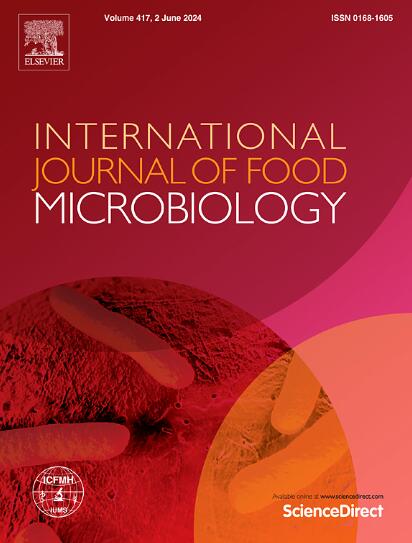Fluoroquinolone susceptibility of wild-type Listeria monocytogenes isolates and the role of FepR and ParC mutations in conferring fluoroquinolone tolerance
IF 5
1区 农林科学
Q1 FOOD SCIENCE & TECHNOLOGY
International journal of food microbiology
Pub Date : 2025-06-03
DOI:10.1016/j.ijfoodmicro.2025.111290
引用次数: 0
Abstract
Fluoroquinolone response and associated genotypic variants were characterized in a set of 88 Listeria monocytogenes strains isolated from Canadian dairy facilities over a span of 10 years. All strains were susceptible to ciprofloxacin (CIP), moxifloxacin (MOX), and levofloxacin (LEV) using the VITEK GP-AST75 assay. However, CIP minimum inhibitory concentrations (MICs) varied in the broth dilution assay, with 47 isolates exhibiting MICs of 1 ppm and 41 isolates at ≤0.5 ppm (detection limit). Isolates with elevated MICs to one fluoroquinolone showed correlated increases in MICs to other fluoroquinolones (Spearman's correlation; p < 0.0001). MICs were confirmed using a broth dilution assay (0.125–8 ppm; two-fold dilution in MHB), with variable growth observed among replicates at sublethal CIP concentrations. After two passages in 0.5 ppm CIP, WRLP81 exhibited increased fitness (reduced lag phase duration) and MIC increases in CIP (4 ppm), LEV (2 ppm), and MOX (1 ppm). Whole genome sequencing of descendants (81.2B; 81.2C) revealed two unique frameshift mutations in fepR: V114fs and Glu139fs. Molecular modeling predicted conformational defects likely impairing FepA dimerization and efflux pump repression. Similarly, after two passages in 0.5 ppm CIP, a WRLP86 descendant (86.2C_2) exhibited increased MICs for CIP (2 ppm), LEV (4 ppm), and MOX (1 ppm), linked to a parC missense mutation that altered the winged helix domain. This amino acid change likely creates steric interference near the fluoroquinolone binding pocket and represents the first report of a parC mutation identified in L. monocytogenes in response to sublethal CIP exposure. This research highlights the rapid and varied adaptation of reduced fluoroquinolone susceptibility in L. monocytogenes.
野生型单核增生李斯特菌对氟喹诺酮的敏感性及FepR和ParC突变在氟喹诺酮耐受性中的作用
对10年间从加拿大奶牛场分离的88株单核增生李斯特菌进行了氟喹诺酮反应和相关基因型变异的研究。所有菌株均对环丙沙星(CIP)、莫西沙星(MOX)和左氧氟沙星(LEV)敏感,采用VITEK GP-AST75检测。然而,在肉汤稀释试验中,CIP最低抑制浓度(mic)各不相同,47株菌株的mic为1 ppm, 41株菌株的mic≤0.5 ppm(检测限)。对一种氟喹诺酮类药物mic升高的分离株与其他氟喹诺酮类药物mic升高相关(Spearman相关性;p & lt;0.0001)。用肉汤稀释法(0.125-8 ppm;在MHB中稀释两倍),在亚致死浓度的CIP重复中观察到不同的生长。在0.5 ppm的CIP环境中,经过两次传代后,WRLP81在CIP (4 ppm)、LEV (2 ppm)和MOX (1 ppm)环境中表现出更高的适应度(延迟期持续时间缩短)和MIC增加。后代全基因组测序(81.2B;81.2C)在fepR中发现了两个独特的移码突变:V114fs和Glu139fs。分子模型预测构象缺陷可能损害FepA二聚化和外排泵抑制。同样,在0.5 ppm的CIP环境中进行两次传代后,WRLP86后代(86.2 2c_2)对CIP (2 ppm)、LEV (4 ppm)和MOX (1 ppm)的mic增加,这与parC错配突变改变了翼状螺旋结构域有关。这种氨基酸变化可能会在氟喹诺酮结合袋附近产生位位干扰,这是首次报道单核增生L.细胞对亚致死CIP暴露的反应中发现parC突变。本研究强调了单核增生乳杆菌对氟喹诺酮类药物敏感性降低的快速和多样化适应。
本文章由计算机程序翻译,如有差异,请以英文原文为准。
求助全文
约1分钟内获得全文
求助全文
来源期刊
CiteScore
10.40
自引率
5.60%
发文量
322
审稿时长
65 days
期刊介绍:
The International Journal of Food Microbiology publishes papers dealing with all aspects of food microbiology. Articles must present information that is novel, has high impact and interest, and is of high scientific quality. They should provide scientific or technological advancement in the specific field of interest of the journal and enhance its strong international reputation. Preliminary or confirmatory results as well as contributions not strictly related to food microbiology will not be considered for publication.

 求助内容:
求助内容: 应助结果提醒方式:
应助结果提醒方式:


